BUSN20017 Effective Business Communication - A Self-Reflection Essay
VerifiedAdded on 2023/06/12
|13
|4935
|75
Essay
AI Summary
This essay presents a self-reflection on effective business communication, utilizing diagnostic tools to identify areas for improvement, specifically public speaking anxiety and tolerance of disagreement. The author analyzes their communication style through verbal, non-verbal, active listening, and assertiveness perspectives, using tools like PRICA, SPCC, Talkaholic Scale, Tolerance for Disagreement, and NISS. The reflection includes real-life examples, such as a job interview and a business meeting, to illustrate communication challenges. A literature review explores theoretical concepts and models related to these issues, informing a 6-month action plan for skill development. The essay aims to enhance the author's confidence and effectiveness in various communication scenarios, contributing to better interpersonal and professional interactions. Desklib provides this student-contributed assignment as a resource.
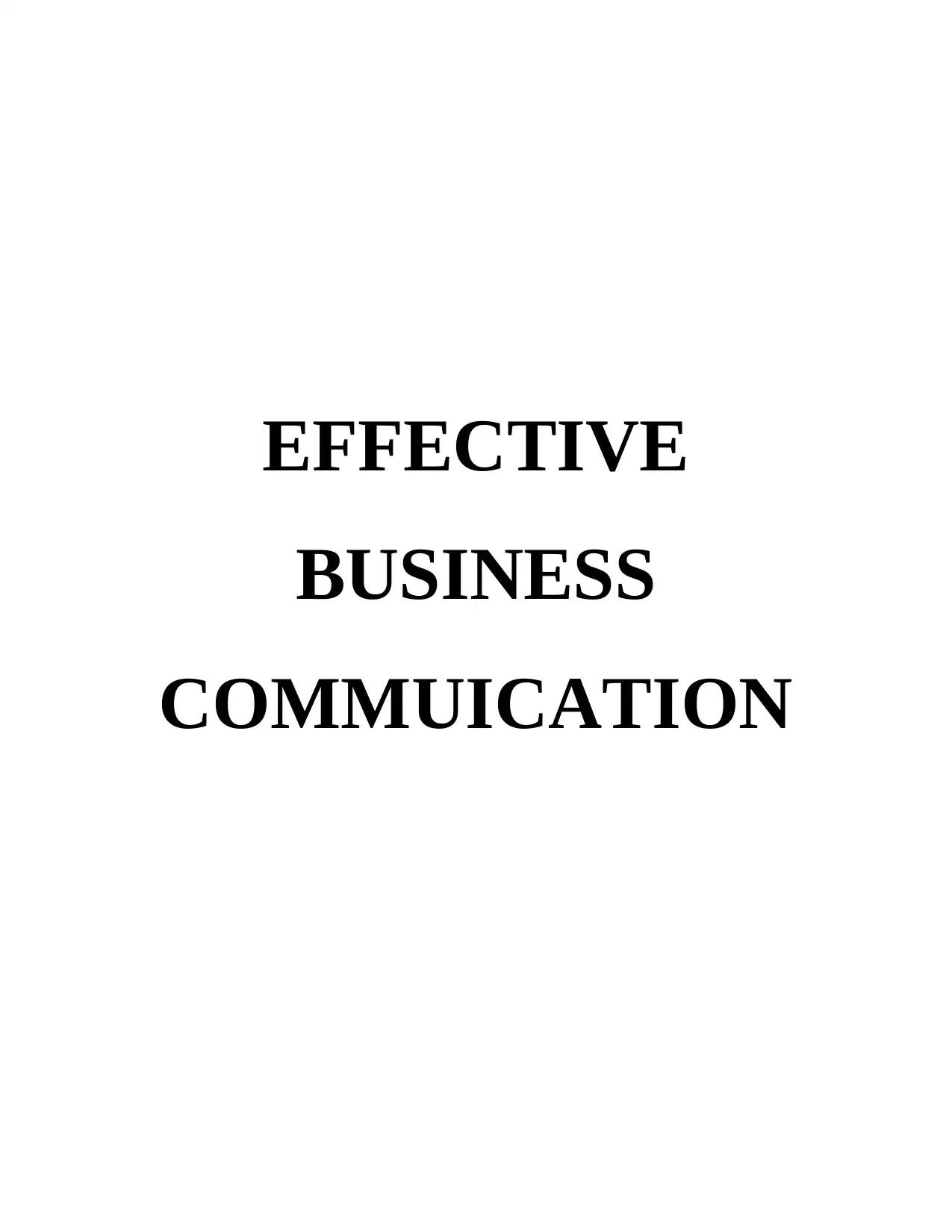
EFFECTIVE
BUSINESS
COMMUICATION
BUSINESS
COMMUICATION
Paraphrase This Document
Need a fresh take? Get an instant paraphrase of this document with our AI Paraphraser
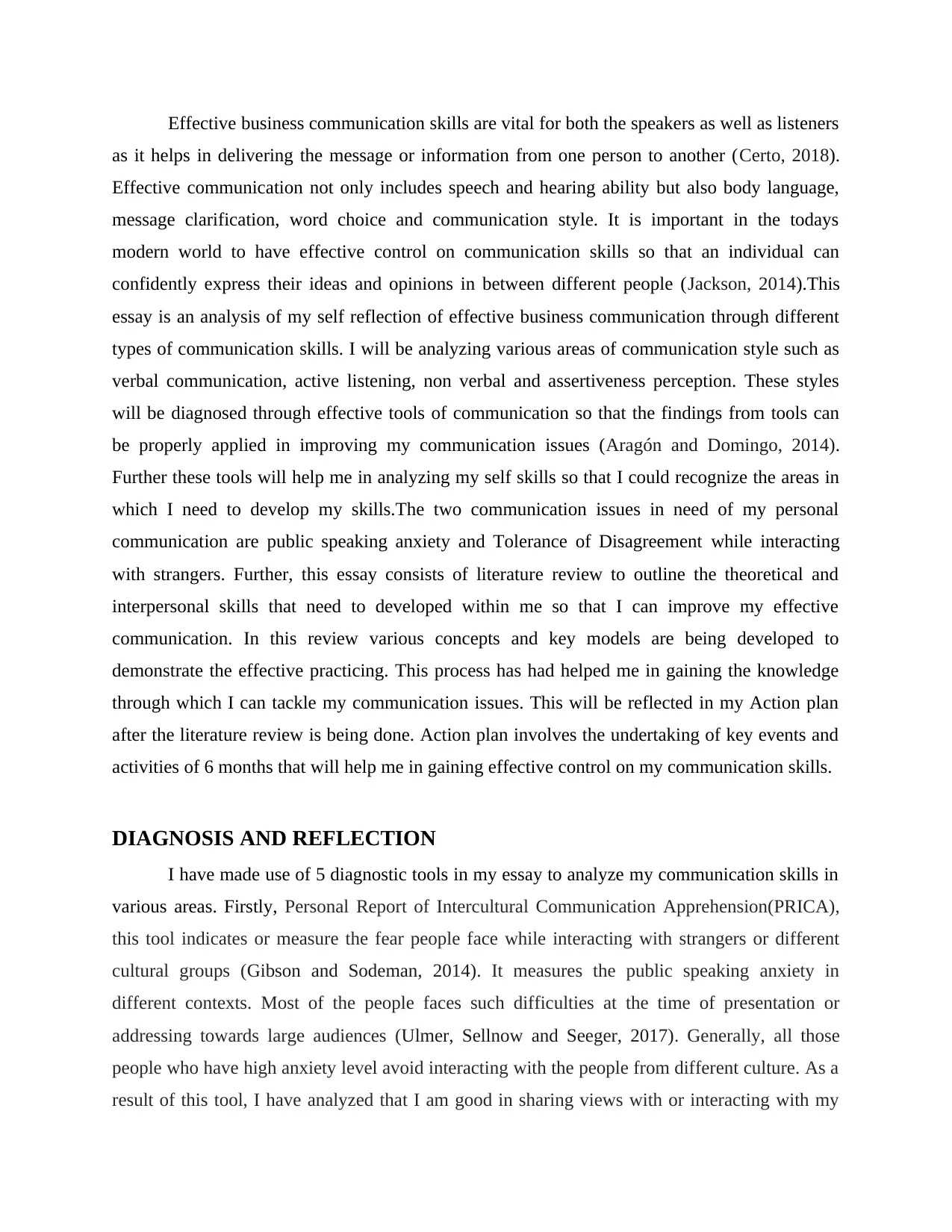
Effective business communication skills are vital for both the speakers as well as listeners
as it helps in delivering the message or information from one person to another (Certo, 2018).
Effective communication not only includes speech and hearing ability but also body language,
message clarification, word choice and communication style. It is important in the todays
modern world to have effective control on communication skills so that an individual can
confidently express their ideas and opinions in between different people (Jackson, 2014).This
essay is an analysis of my self reflection of effective business communication through different
types of communication skills. I will be analyzing various areas of communication style such as
verbal communication, active listening, non verbal and assertiveness perception. These styles
will be diagnosed through effective tools of communication so that the findings from tools can
be properly applied in improving my communication issues (Aragón and Domingo, 2014).
Further these tools will help me in analyzing my self skills so that I could recognize the areas in
which I need to develop my skills.The two communication issues in need of my personal
communication are public speaking anxiety and Tolerance of Disagreement while interacting
with strangers. Further, this essay consists of literature review to outline the theoretical and
interpersonal skills that need to developed within me so that I can improve my effective
communication. In this review various concepts and key models are being developed to
demonstrate the effective practicing. This process has had helped me in gaining the knowledge
through which I can tackle my communication issues. This will be reflected in my Action plan
after the literature review is being done. Action plan involves the undertaking of key events and
activities of 6 months that will help me in gaining effective control on my communication skills.
DIAGNOSIS AND REFLECTION
I have made use of 5 diagnostic tools in my essay to analyze my communication skills in
various areas. Firstly, Personal Report of Intercultural Communication Apprehension(PRICA),
this tool indicates or measure the fear people face while interacting with strangers or different
cultural groups (Gibson and Sodeman, 2014). It measures the public speaking anxiety in
different contexts. Most of the people faces such difficulties at the time of presentation or
addressing towards large audiences (Ulmer, Sellnow and Seeger, 2017). Generally, all those
people who have high anxiety level avoid interacting with the people from different culture. As a
result of this tool, I have analyzed that I am good in sharing views with or interacting with my
as it helps in delivering the message or information from one person to another (Certo, 2018).
Effective communication not only includes speech and hearing ability but also body language,
message clarification, word choice and communication style. It is important in the todays
modern world to have effective control on communication skills so that an individual can
confidently express their ideas and opinions in between different people (Jackson, 2014).This
essay is an analysis of my self reflection of effective business communication through different
types of communication skills. I will be analyzing various areas of communication style such as
verbal communication, active listening, non verbal and assertiveness perception. These styles
will be diagnosed through effective tools of communication so that the findings from tools can
be properly applied in improving my communication issues (Aragón and Domingo, 2014).
Further these tools will help me in analyzing my self skills so that I could recognize the areas in
which I need to develop my skills.The two communication issues in need of my personal
communication are public speaking anxiety and Tolerance of Disagreement while interacting
with strangers. Further, this essay consists of literature review to outline the theoretical and
interpersonal skills that need to developed within me so that I can improve my effective
communication. In this review various concepts and key models are being developed to
demonstrate the effective practicing. This process has had helped me in gaining the knowledge
through which I can tackle my communication issues. This will be reflected in my Action plan
after the literature review is being done. Action plan involves the undertaking of key events and
activities of 6 months that will help me in gaining effective control on my communication skills.
DIAGNOSIS AND REFLECTION
I have made use of 5 diagnostic tools in my essay to analyze my communication skills in
various areas. Firstly, Personal Report of Intercultural Communication Apprehension(PRICA),
this tool indicates or measure the fear people face while interacting with strangers or different
cultural groups (Gibson and Sodeman, 2014). It measures the public speaking anxiety in
different contexts. Most of the people faces such difficulties at the time of presentation or
addressing towards large audiences (Ulmer, Sellnow and Seeger, 2017). Generally, all those
people who have high anxiety level avoid interacting with the people from different culture. As a
result of this tool, I have analyzed that I am good in sharing views with or interacting with my
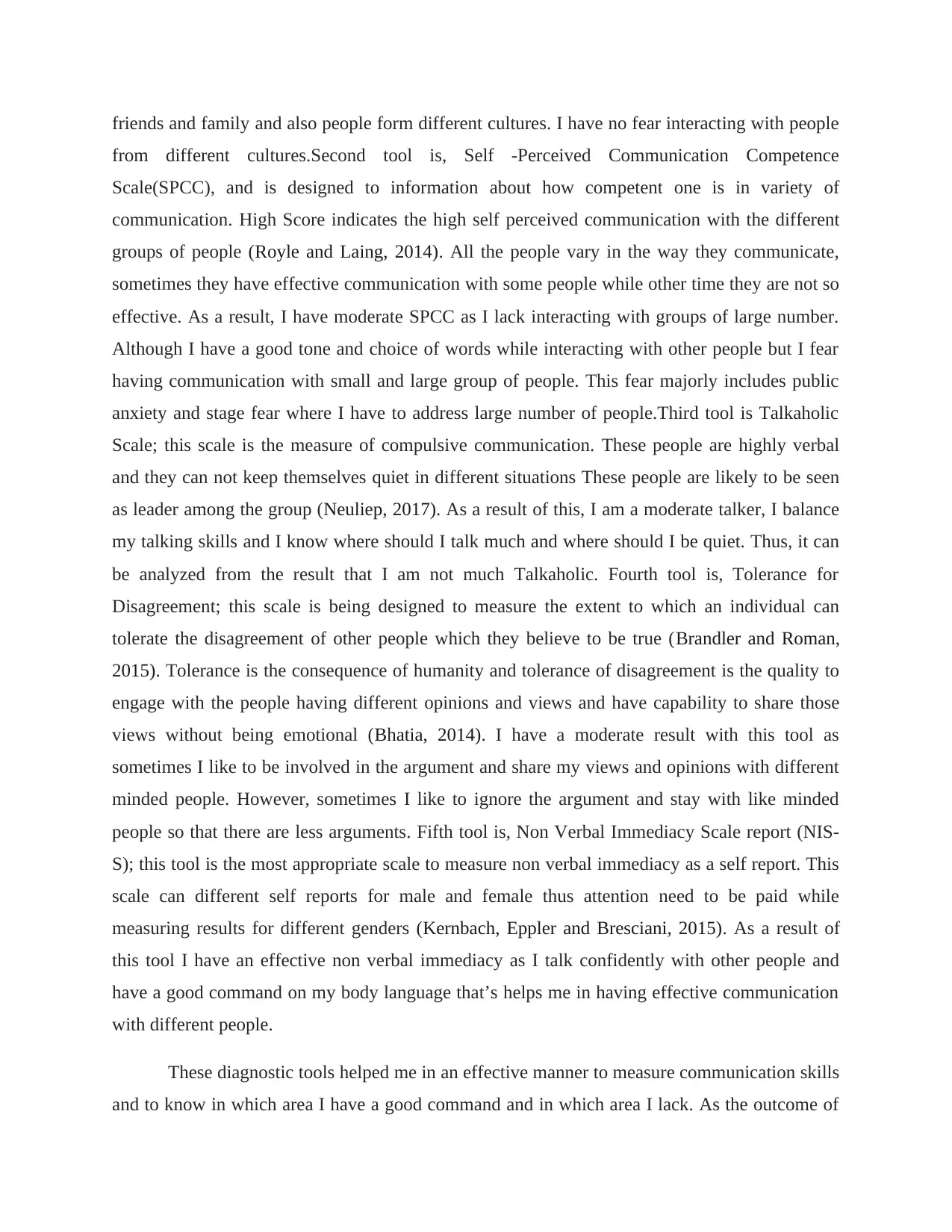
friends and family and also people form different cultures. I have no fear interacting with people
from different cultures.Second tool is, Self -Perceived Communication Competence
Scale(SPCC), and is designed to information about how competent one is in variety of
communication. High Score indicates the high self perceived communication with the different
groups of people (Royle and Laing, 2014). All the people vary in the way they communicate,
sometimes they have effective communication with some people while other time they are not so
effective. As a result, I have moderate SPCC as I lack interacting with groups of large number.
Although I have a good tone and choice of words while interacting with other people but I fear
having communication with small and large group of people. This fear majorly includes public
anxiety and stage fear where I have to address large number of people.Third tool is Talkaholic
Scale; this scale is the measure of compulsive communication. These people are highly verbal
and they can not keep themselves quiet in different situations These people are likely to be seen
as leader among the group (Neuliep, 2017). As a result of this, I am a moderate talker, I balance
my talking skills and I know where should I talk much and where should I be quiet. Thus, it can
be analyzed from the result that I am not much Talkaholic. Fourth tool is, Tolerance for
Disagreement; this scale is being designed to measure the extent to which an individual can
tolerate the disagreement of other people which they believe to be true (Brandler and Roman,
2015). Tolerance is the consequence of humanity and tolerance of disagreement is the quality to
engage with the people having different opinions and views and have capability to share those
views without being emotional (Bhatia, 2014). I have a moderate result with this tool as
sometimes I like to be involved in the argument and share my views and opinions with different
minded people. However, sometimes I like to ignore the argument and stay with like minded
people so that there are less arguments. Fifth tool is, Non Verbal Immediacy Scale report (NIS-
S); this tool is the most appropriate scale to measure non verbal immediacy as a self report. This
scale can different self reports for male and female thus attention need to be paid while
measuring results for different genders (Kernbach, Eppler and Bresciani, 2015). As a result of
this tool I have an effective non verbal immediacy as I talk confidently with other people and
have a good command on my body language that’s helps me in having effective communication
with different people.
These diagnostic tools helped me in an effective manner to measure communication skills
and to know in which area I have a good command and in which area I lack. As the outcome of
from different cultures.Second tool is, Self -Perceived Communication Competence
Scale(SPCC), and is designed to information about how competent one is in variety of
communication. High Score indicates the high self perceived communication with the different
groups of people (Royle and Laing, 2014). All the people vary in the way they communicate,
sometimes they have effective communication with some people while other time they are not so
effective. As a result, I have moderate SPCC as I lack interacting with groups of large number.
Although I have a good tone and choice of words while interacting with other people but I fear
having communication with small and large group of people. This fear majorly includes public
anxiety and stage fear where I have to address large number of people.Third tool is Talkaholic
Scale; this scale is the measure of compulsive communication. These people are highly verbal
and they can not keep themselves quiet in different situations These people are likely to be seen
as leader among the group (Neuliep, 2017). As a result of this, I am a moderate talker, I balance
my talking skills and I know where should I talk much and where should I be quiet. Thus, it can
be analyzed from the result that I am not much Talkaholic. Fourth tool is, Tolerance for
Disagreement; this scale is being designed to measure the extent to which an individual can
tolerate the disagreement of other people which they believe to be true (Brandler and Roman,
2015). Tolerance is the consequence of humanity and tolerance of disagreement is the quality to
engage with the people having different opinions and views and have capability to share those
views without being emotional (Bhatia, 2014). I have a moderate result with this tool as
sometimes I like to be involved in the argument and share my views and opinions with different
minded people. However, sometimes I like to ignore the argument and stay with like minded
people so that there are less arguments. Fifth tool is, Non Verbal Immediacy Scale report (NIS-
S); this tool is the most appropriate scale to measure non verbal immediacy as a self report. This
scale can different self reports for male and female thus attention need to be paid while
measuring results for different genders (Kernbach, Eppler and Bresciani, 2015). As a result of
this tool I have an effective non verbal immediacy as I talk confidently with other people and
have a good command on my body language that’s helps me in having effective communication
with different people.
These diagnostic tools helped me in an effective manner to measure communication skills
and to know in which area I have a good command and in which area I lack. As the outcome of
⊘ This is a preview!⊘
Do you want full access?
Subscribe today to unlock all pages.

Trusted by 1+ million students worldwide
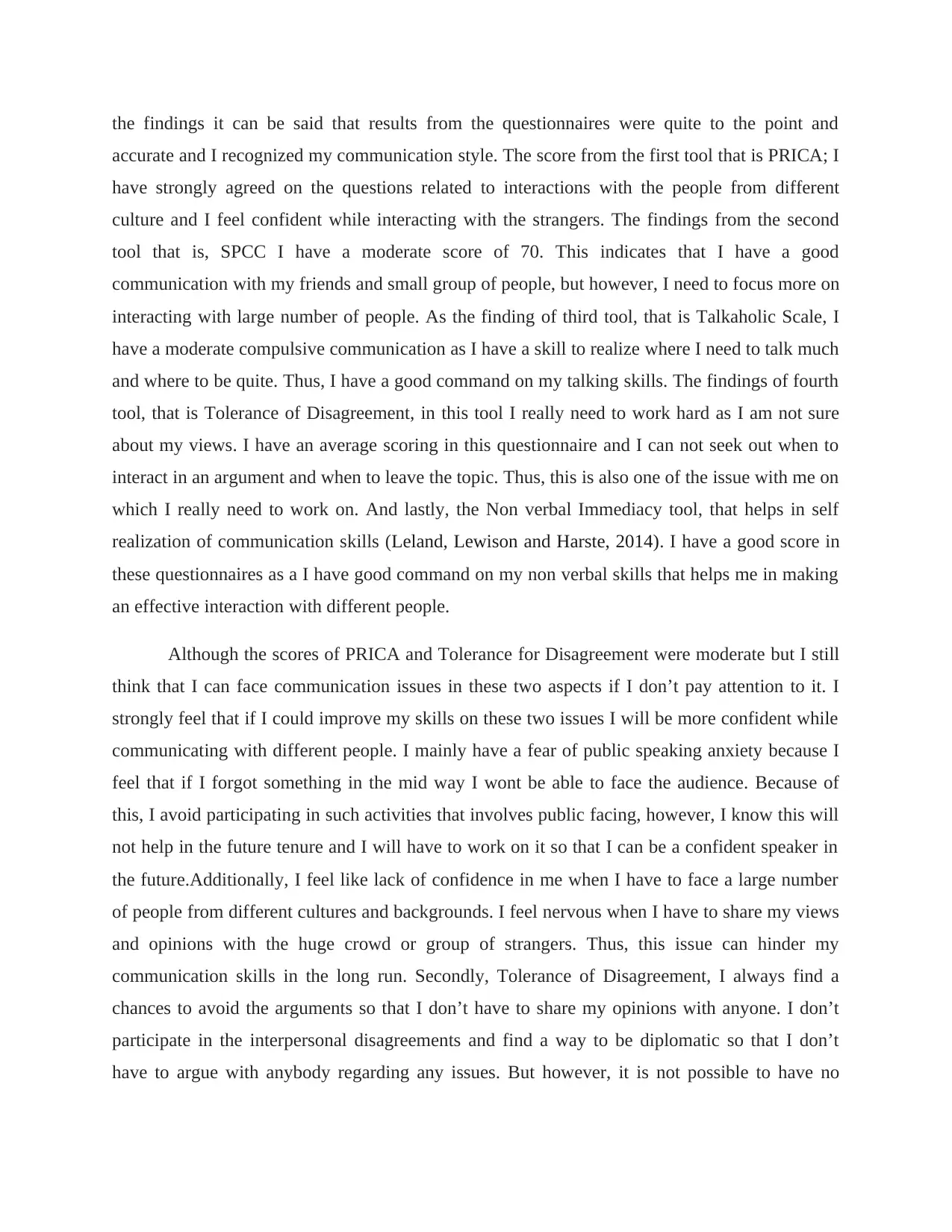
the findings it can be said that results from the questionnaires were quite to the point and
accurate and I recognized my communication style. The score from the first tool that is PRICA; I
have strongly agreed on the questions related to interactions with the people from different
culture and I feel confident while interacting with the strangers. The findings from the second
tool that is, SPCC I have a moderate score of 70. This indicates that I have a good
communication with my friends and small group of people, but however, I need to focus more on
interacting with large number of people. As the finding of third tool, that is Talkaholic Scale, I
have a moderate compulsive communication as I have a skill to realize where I need to talk much
and where to be quite. Thus, I have a good command on my talking skills. The findings of fourth
tool, that is Tolerance of Disagreement, in this tool I really need to work hard as I am not sure
about my views. I have an average scoring in this questionnaire and I can not seek out when to
interact in an argument and when to leave the topic. Thus, this is also one of the issue with me on
which I really need to work on. And lastly, the Non verbal Immediacy tool, that helps in self
realization of communication skills (Leland, Lewison and Harste, 2014). I have a good score in
these questionnaires as a I have good command on my non verbal skills that helps me in making
an effective interaction with different people.
Although the scores of PRICA and Tolerance for Disagreement were moderate but I still
think that I can face communication issues in these two aspects if I don’t pay attention to it. I
strongly feel that if I could improve my skills on these two issues I will be more confident while
communicating with different people. I mainly have a fear of public speaking anxiety because I
feel that if I forgot something in the mid way I wont be able to face the audience. Because of
this, I avoid participating in such activities that involves public facing, however, I know this will
not help in the future tenure and I will have to work on it so that I can be a confident speaker in
the future.Additionally, I feel like lack of confidence in me when I have to face a large number
of people from different cultures and backgrounds. I feel nervous when I have to share my views
and opinions with the huge crowd or group of strangers. Thus, this issue can hinder my
communication skills in the long run. Secondly, Tolerance of Disagreement, I always find a
chances to avoid the arguments so that I don’t have to share my opinions with anyone. I don’t
participate in the interpersonal disagreements and find a way to be diplomatic so that I don’t
have to argue with anybody regarding any issues. But however, it is not possible to have no
accurate and I recognized my communication style. The score from the first tool that is PRICA; I
have strongly agreed on the questions related to interactions with the people from different
culture and I feel confident while interacting with the strangers. The findings from the second
tool that is, SPCC I have a moderate score of 70. This indicates that I have a good
communication with my friends and small group of people, but however, I need to focus more on
interacting with large number of people. As the finding of third tool, that is Talkaholic Scale, I
have a moderate compulsive communication as I have a skill to realize where I need to talk much
and where to be quite. Thus, I have a good command on my talking skills. The findings of fourth
tool, that is Tolerance of Disagreement, in this tool I really need to work hard as I am not sure
about my views. I have an average scoring in this questionnaire and I can not seek out when to
interact in an argument and when to leave the topic. Thus, this is also one of the issue with me on
which I really need to work on. And lastly, the Non verbal Immediacy tool, that helps in self
realization of communication skills (Leland, Lewison and Harste, 2014). I have a good score in
these questionnaires as a I have good command on my non verbal skills that helps me in making
an effective interaction with different people.
Although the scores of PRICA and Tolerance for Disagreement were moderate but I still
think that I can face communication issues in these two aspects if I don’t pay attention to it. I
strongly feel that if I could improve my skills on these two issues I will be more confident while
communicating with different people. I mainly have a fear of public speaking anxiety because I
feel that if I forgot something in the mid way I wont be able to face the audience. Because of
this, I avoid participating in such activities that involves public facing, however, I know this will
not help in the future tenure and I will have to work on it so that I can be a confident speaker in
the future.Additionally, I feel like lack of confidence in me when I have to face a large number
of people from different cultures and backgrounds. I feel nervous when I have to share my views
and opinions with the huge crowd or group of strangers. Thus, this issue can hinder my
communication skills in the long run. Secondly, Tolerance of Disagreement, I always find a
chances to avoid the arguments so that I don’t have to share my opinions with anyone. I don’t
participate in the interpersonal disagreements and find a way to be diplomatic so that I don’t
have to argue with anybody regarding any issues. But however, it is not possible to have no
Paraphrase This Document
Need a fresh take? Get an instant paraphrase of this document with our AI Paraphraser
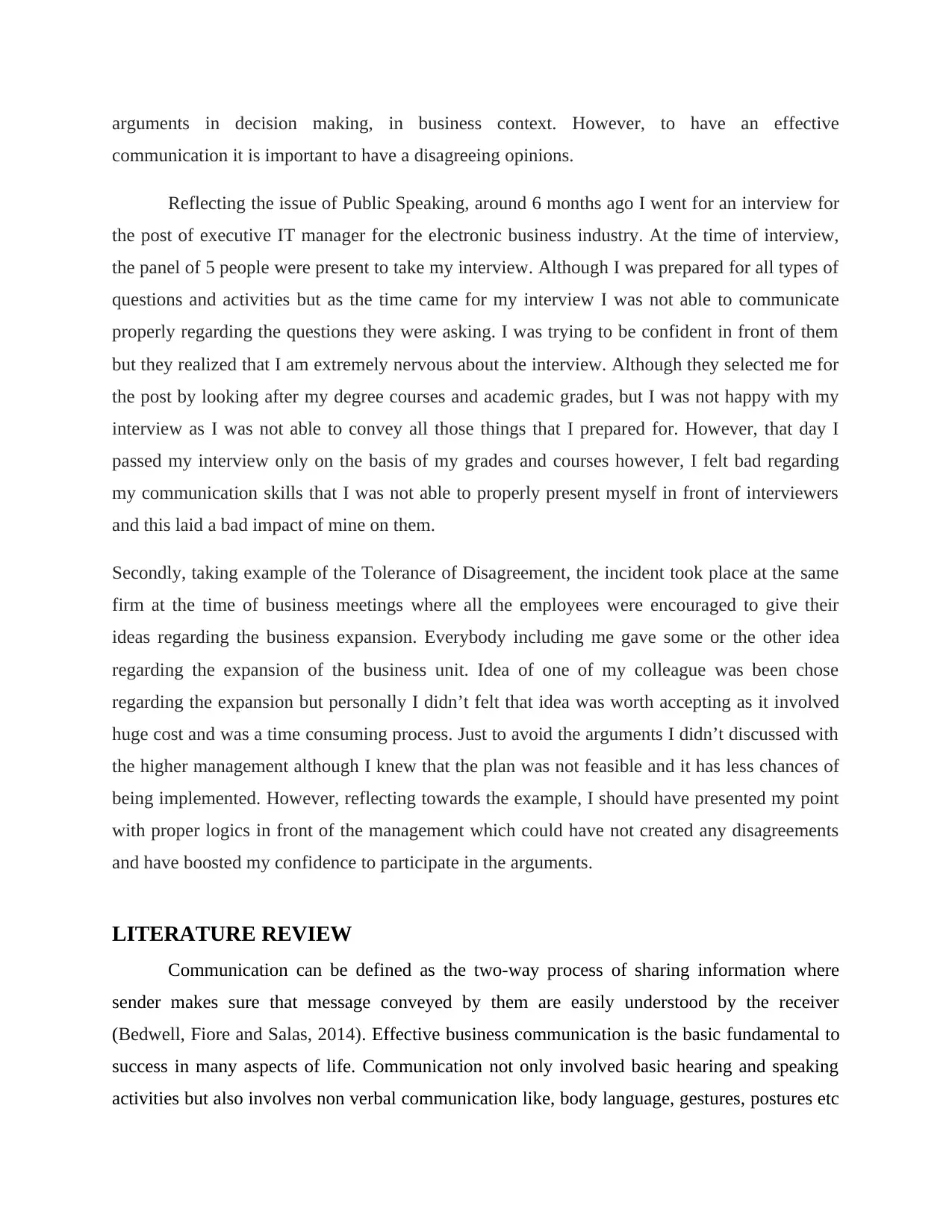
arguments in decision making, in business context. However, to have an effective
communication it is important to have a disagreeing opinions.
Reflecting the issue of Public Speaking, around 6 months ago I went for an interview for
the post of executive IT manager for the electronic business industry. At the time of interview,
the panel of 5 people were present to take my interview. Although I was prepared for all types of
questions and activities but as the time came for my interview I was not able to communicate
properly regarding the questions they were asking. I was trying to be confident in front of them
but they realized that I am extremely nervous about the interview. Although they selected me for
the post by looking after my degree courses and academic grades, but I was not happy with my
interview as I was not able to convey all those things that I prepared for. However, that day I
passed my interview only on the basis of my grades and courses however, I felt bad regarding
my communication skills that I was not able to properly present myself in front of interviewers
and this laid a bad impact of mine on them.
Secondly, taking example of the Tolerance of Disagreement, the incident took place at the same
firm at the time of business meetings where all the employees were encouraged to give their
ideas regarding the business expansion. Everybody including me gave some or the other idea
regarding the expansion of the business unit. Idea of one of my colleague was been chose
regarding the expansion but personally I didn’t felt that idea was worth accepting as it involved
huge cost and was a time consuming process. Just to avoid the arguments I didn’t discussed with
the higher management although I knew that the plan was not feasible and it has less chances of
being implemented. However, reflecting towards the example, I should have presented my point
with proper logics in front of the management which could have not created any disagreements
and have boosted my confidence to participate in the arguments.
LITERATURE REVIEW
Communication can be defined as the two-way process of sharing information where
sender makes sure that message conveyed by them are easily understood by the receiver
(Bedwell, Fiore and Salas, 2014). Effective business communication is the basic fundamental to
success in many aspects of life. Communication not only involved basic hearing and speaking
activities but also involves non verbal communication like, body language, gestures, postures etc
communication it is important to have a disagreeing opinions.
Reflecting the issue of Public Speaking, around 6 months ago I went for an interview for
the post of executive IT manager for the electronic business industry. At the time of interview,
the panel of 5 people were present to take my interview. Although I was prepared for all types of
questions and activities but as the time came for my interview I was not able to communicate
properly regarding the questions they were asking. I was trying to be confident in front of them
but they realized that I am extremely nervous about the interview. Although they selected me for
the post by looking after my degree courses and academic grades, but I was not happy with my
interview as I was not able to convey all those things that I prepared for. However, that day I
passed my interview only on the basis of my grades and courses however, I felt bad regarding
my communication skills that I was not able to properly present myself in front of interviewers
and this laid a bad impact of mine on them.
Secondly, taking example of the Tolerance of Disagreement, the incident took place at the same
firm at the time of business meetings where all the employees were encouraged to give their
ideas regarding the business expansion. Everybody including me gave some or the other idea
regarding the expansion of the business unit. Idea of one of my colleague was been chose
regarding the expansion but personally I didn’t felt that idea was worth accepting as it involved
huge cost and was a time consuming process. Just to avoid the arguments I didn’t discussed with
the higher management although I knew that the plan was not feasible and it has less chances of
being implemented. However, reflecting towards the example, I should have presented my point
with proper logics in front of the management which could have not created any disagreements
and have boosted my confidence to participate in the arguments.
LITERATURE REVIEW
Communication can be defined as the two-way process of sharing information where
sender makes sure that message conveyed by them are easily understood by the receiver
(Bedwell, Fiore and Salas, 2014). Effective business communication is the basic fundamental to
success in many aspects of life. Communication not only involved basic hearing and speaking
activities but also involves non verbal communication like, body language, gestures, postures etc
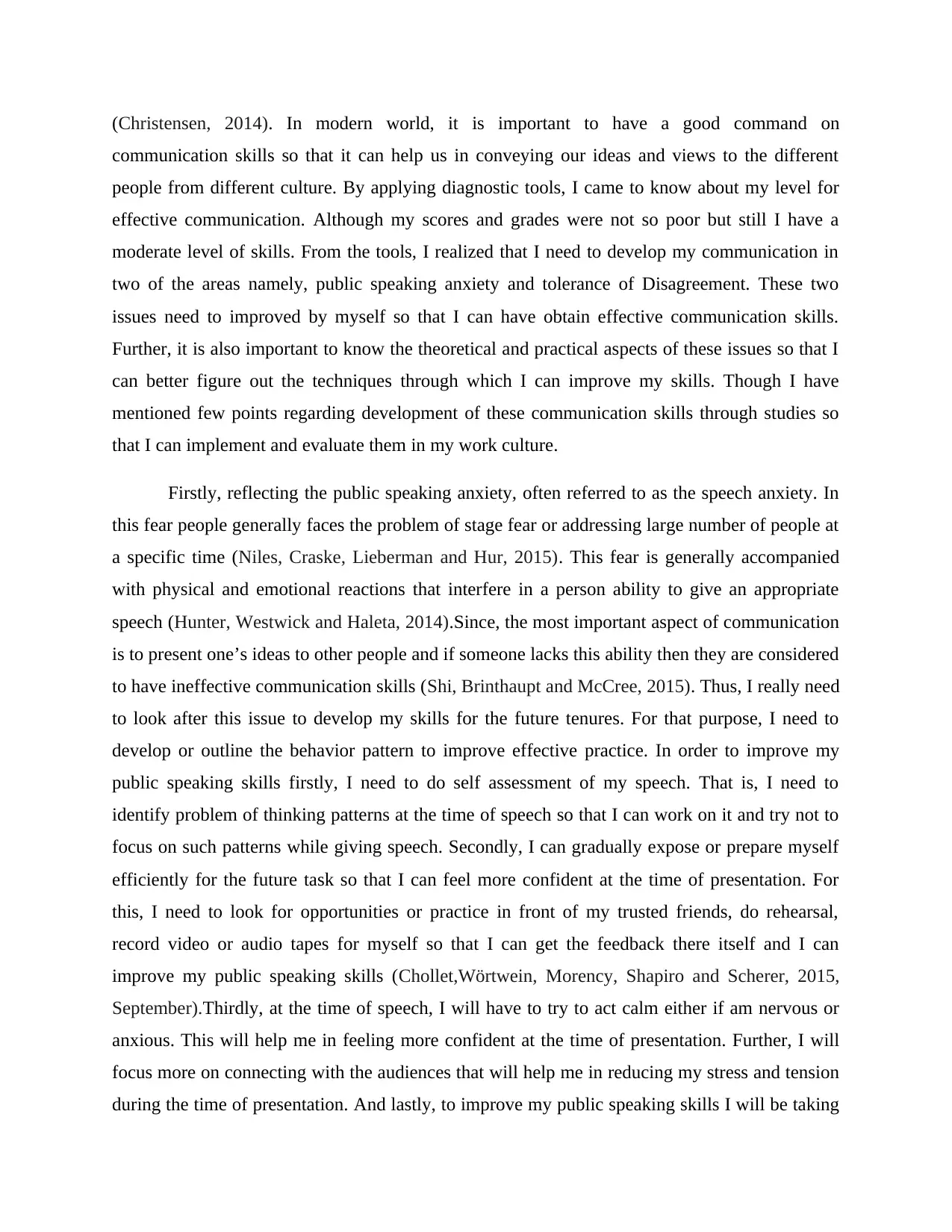
(Christensen, 2014). In modern world, it is important to have a good command on
communication skills so that it can help us in conveying our ideas and views to the different
people from different culture. By applying diagnostic tools, I came to know about my level for
effective communication. Although my scores and grades were not so poor but still I have a
moderate level of skills. From the tools, I realized that I need to develop my communication in
two of the areas namely, public speaking anxiety and tolerance of Disagreement. These two
issues need to improved by myself so that I can have obtain effective communication skills.
Further, it is also important to know the theoretical and practical aspects of these issues so that I
can better figure out the techniques through which I can improve my skills. Though I have
mentioned few points regarding development of these communication skills through studies so
that I can implement and evaluate them in my work culture.
Firstly, reflecting the public speaking anxiety, often referred to as the speech anxiety. In
this fear people generally faces the problem of stage fear or addressing large number of people at
a specific time (Niles, Craske, Lieberman and Hur, 2015). This fear is generally accompanied
with physical and emotional reactions that interfere in a person ability to give an appropriate
speech (Hunter, Westwick and Haleta, 2014).Since, the most important aspect of communication
is to present one’s ideas to other people and if someone lacks this ability then they are considered
to have ineffective communication skills (Shi, Brinthaupt and McCree, 2015). Thus, I really need
to look after this issue to develop my skills for the future tenures. For that purpose, I need to
develop or outline the behavior pattern to improve effective practice. In order to improve my
public speaking skills firstly, I need to do self assessment of my speech. That is, I need to
identify problem of thinking patterns at the time of speech so that I can work on it and try not to
focus on such patterns while giving speech. Secondly, I can gradually expose or prepare myself
efficiently for the future task so that I can feel more confident at the time of presentation. For
this, I need to look for opportunities or practice in front of my trusted friends, do rehearsal,
record video or audio tapes for myself so that I can get the feedback there itself and I can
improve my public speaking skills (Chollet,Wörtwein, Morency, Shapiro and Scherer, 2015,
September).Thirdly, at the time of speech, I will have to try to act calm either if am nervous or
anxious. This will help me in feeling more confident at the time of presentation. Further, I will
focus more on connecting with the audiences that will help me in reducing my stress and tension
during the time of presentation. And lastly, to improve my public speaking skills I will be taking
communication skills so that it can help us in conveying our ideas and views to the different
people from different culture. By applying diagnostic tools, I came to know about my level for
effective communication. Although my scores and grades were not so poor but still I have a
moderate level of skills. From the tools, I realized that I need to develop my communication in
two of the areas namely, public speaking anxiety and tolerance of Disagreement. These two
issues need to improved by myself so that I can have obtain effective communication skills.
Further, it is also important to know the theoretical and practical aspects of these issues so that I
can better figure out the techniques through which I can improve my skills. Though I have
mentioned few points regarding development of these communication skills through studies so
that I can implement and evaluate them in my work culture.
Firstly, reflecting the public speaking anxiety, often referred to as the speech anxiety. In
this fear people generally faces the problem of stage fear or addressing large number of people at
a specific time (Niles, Craske, Lieberman and Hur, 2015). This fear is generally accompanied
with physical and emotional reactions that interfere in a person ability to give an appropriate
speech (Hunter, Westwick and Haleta, 2014).Since, the most important aspect of communication
is to present one’s ideas to other people and if someone lacks this ability then they are considered
to have ineffective communication skills (Shi, Brinthaupt and McCree, 2015). Thus, I really need
to look after this issue to develop my skills for the future tenures. For that purpose, I need to
develop or outline the behavior pattern to improve effective practice. In order to improve my
public speaking skills firstly, I need to do self assessment of my speech. That is, I need to
identify problem of thinking patterns at the time of speech so that I can work on it and try not to
focus on such patterns while giving speech. Secondly, I can gradually expose or prepare myself
efficiently for the future task so that I can feel more confident at the time of presentation. For
this, I need to look for opportunities or practice in front of my trusted friends, do rehearsal,
record video or audio tapes for myself so that I can get the feedback there itself and I can
improve my public speaking skills (Chollet,Wörtwein, Morency, Shapiro and Scherer, 2015,
September).Thirdly, at the time of speech, I will have to try to act calm either if am nervous or
anxious. This will help me in feeling more confident at the time of presentation. Further, I will
focus more on connecting with the audiences that will help me in reducing my stress and tension
during the time of presentation. And lastly, to improve my public speaking skills I will be taking
⊘ This is a preview!⊘
Do you want full access?
Subscribe today to unlock all pages.

Trusted by 1+ million students worldwide
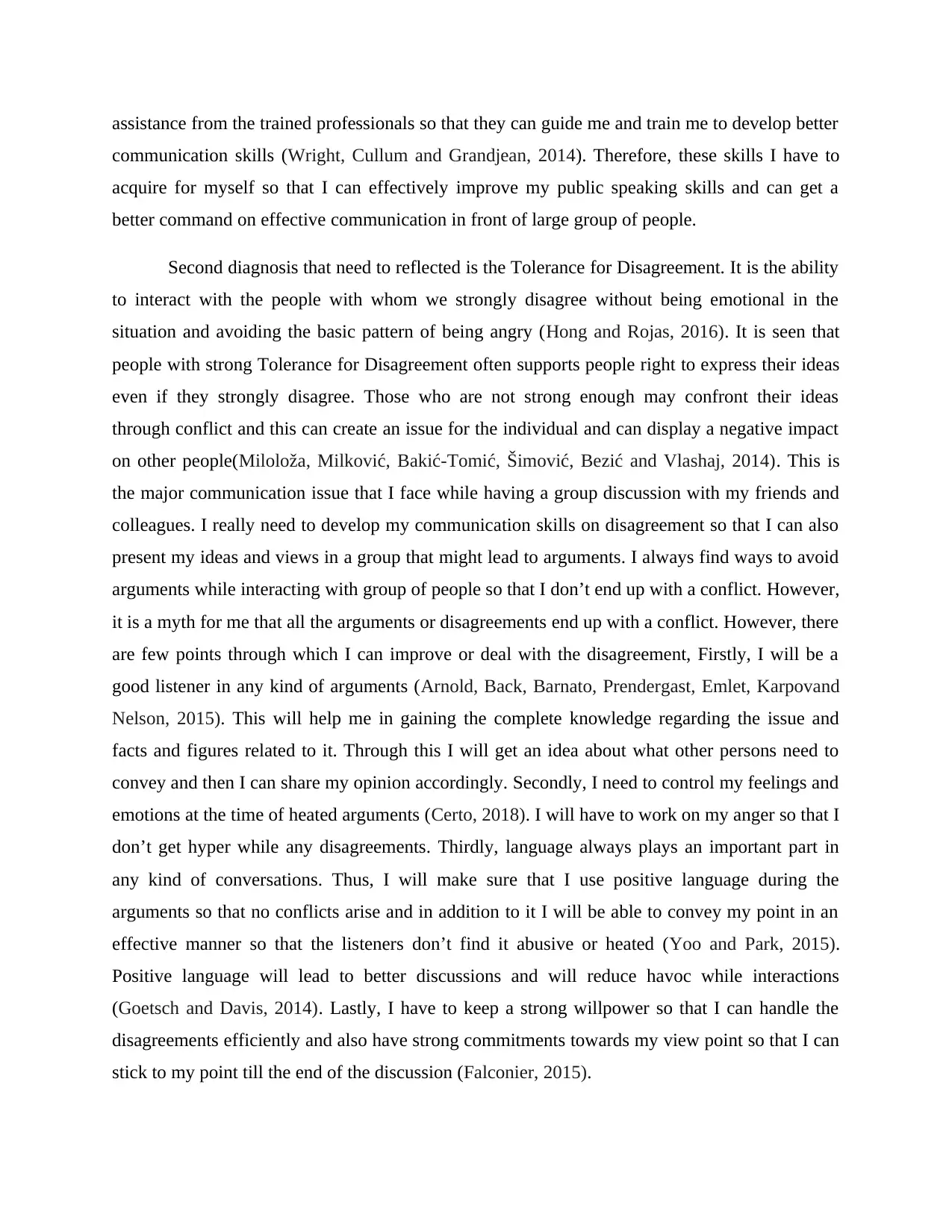
assistance from the trained professionals so that they can guide me and train me to develop better
communication skills (Wright, Cullum and Grandjean, 2014). Therefore, these skills I have to
acquire for myself so that I can effectively improve my public speaking skills and can get a
better command on effective communication in front of large group of people.
Second diagnosis that need to reflected is the Tolerance for Disagreement. It is the ability
to interact with the people with whom we strongly disagree without being emotional in the
situation and avoiding the basic pattern of being angry (Hong and Rojas, 2016). It is seen that
people with strong Tolerance for Disagreement often supports people right to express their ideas
even if they strongly disagree. Those who are not strong enough may confront their ideas
through conflict and this can create an issue for the individual and can display a negative impact
on other people(Miloloža, Milković, Bakić-Tomić, Šimović, Bezić and Vlashaj, 2014). This is
the major communication issue that I face while having a group discussion with my friends and
colleagues. I really need to develop my communication skills on disagreement so that I can also
present my ideas and views in a group that might lead to arguments. I always find ways to avoid
arguments while interacting with group of people so that I don’t end up with a conflict. However,
it is a myth for me that all the arguments or disagreements end up with a conflict. However, there
are few points through which I can improve or deal with the disagreement, Firstly, I will be a
good listener in any kind of arguments (Arnold, Back, Barnato, Prendergast, Emlet, Karpovand
Nelson, 2015). This will help me in gaining the complete knowledge regarding the issue and
facts and figures related to it. Through this I will get an idea about what other persons need to
convey and then I can share my opinion accordingly. Secondly, I need to control my feelings and
emotions at the time of heated arguments (Certo, 2018). I will have to work on my anger so that I
don’t get hyper while any disagreements. Thirdly, language always plays an important part in
any kind of conversations. Thus, I will make sure that I use positive language during the
arguments so that no conflicts arise and in addition to it I will be able to convey my point in an
effective manner so that the listeners don’t find it abusive or heated (Yoo and Park, 2015).
Positive language will lead to better discussions and will reduce havoc while interactions
(Goetsch and Davis, 2014). Lastly, I have to keep a strong willpower so that I can handle the
disagreements efficiently and also have strong commitments towards my view point so that I can
stick to my point till the end of the discussion (Falconier, 2015).
communication skills (Wright, Cullum and Grandjean, 2014). Therefore, these skills I have to
acquire for myself so that I can effectively improve my public speaking skills and can get a
better command on effective communication in front of large group of people.
Second diagnosis that need to reflected is the Tolerance for Disagreement. It is the ability
to interact with the people with whom we strongly disagree without being emotional in the
situation and avoiding the basic pattern of being angry (Hong and Rojas, 2016). It is seen that
people with strong Tolerance for Disagreement often supports people right to express their ideas
even if they strongly disagree. Those who are not strong enough may confront their ideas
through conflict and this can create an issue for the individual and can display a negative impact
on other people(Miloloža, Milković, Bakić-Tomić, Šimović, Bezić and Vlashaj, 2014). This is
the major communication issue that I face while having a group discussion with my friends and
colleagues. I really need to develop my communication skills on disagreement so that I can also
present my ideas and views in a group that might lead to arguments. I always find ways to avoid
arguments while interacting with group of people so that I don’t end up with a conflict. However,
it is a myth for me that all the arguments or disagreements end up with a conflict. However, there
are few points through which I can improve or deal with the disagreement, Firstly, I will be a
good listener in any kind of arguments (Arnold, Back, Barnato, Prendergast, Emlet, Karpovand
Nelson, 2015). This will help me in gaining the complete knowledge regarding the issue and
facts and figures related to it. Through this I will get an idea about what other persons need to
convey and then I can share my opinion accordingly. Secondly, I need to control my feelings and
emotions at the time of heated arguments (Certo, 2018). I will have to work on my anger so that I
don’t get hyper while any disagreements. Thirdly, language always plays an important part in
any kind of conversations. Thus, I will make sure that I use positive language during the
arguments so that no conflicts arise and in addition to it I will be able to convey my point in an
effective manner so that the listeners don’t find it abusive or heated (Yoo and Park, 2015).
Positive language will lead to better discussions and will reduce havoc while interactions
(Goetsch and Davis, 2014). Lastly, I have to keep a strong willpower so that I can handle the
disagreements efficiently and also have strong commitments towards my view point so that I can
stick to my point till the end of the discussion (Falconier, 2015).
Paraphrase This Document
Need a fresh take? Get an instant paraphrase of this document with our AI Paraphraser
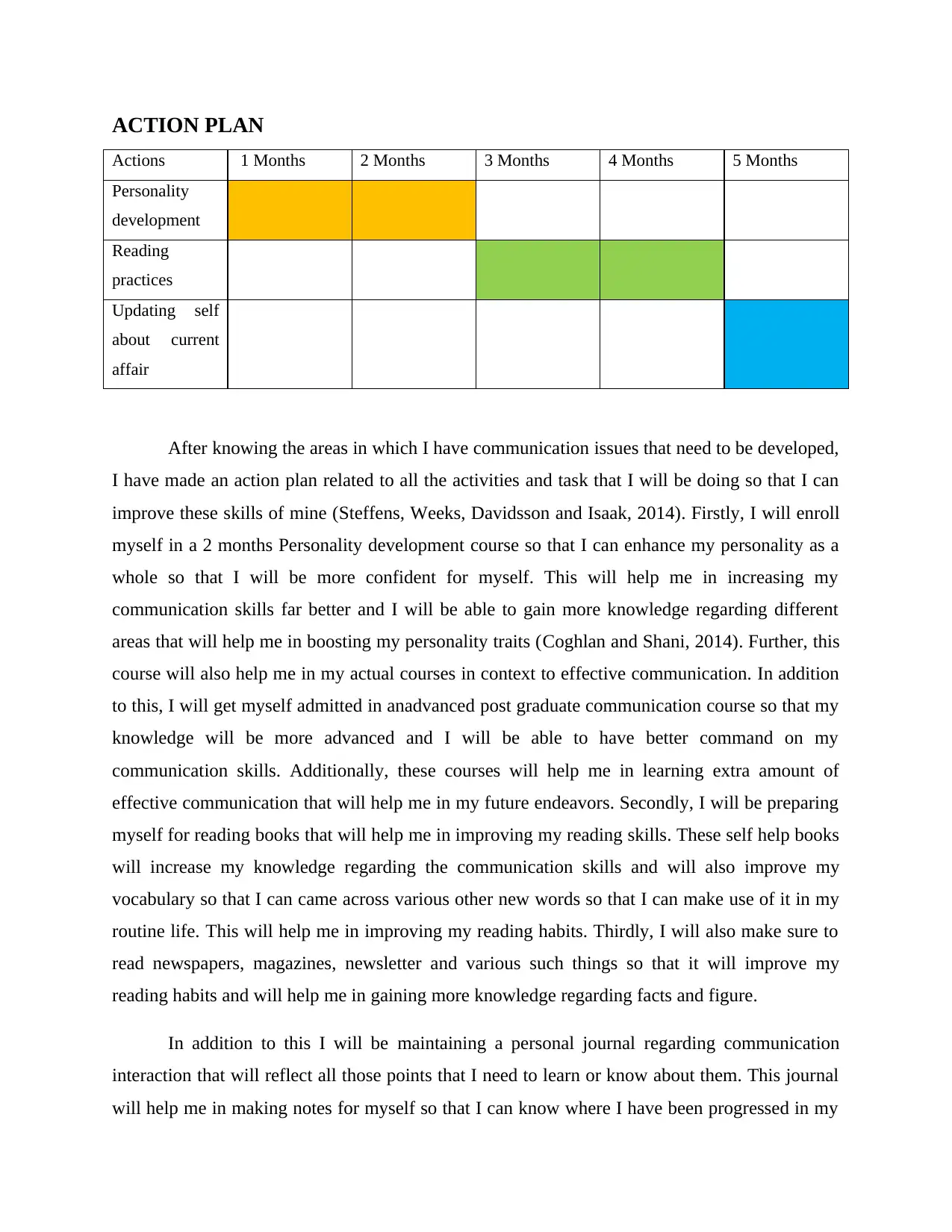
ACTION PLAN
Actions 1 Months 2 Months 3 Months 4 Months 5 Months
Personality
development
Reading
practices
Updating self
about current
affair
After knowing the areas in which I have communication issues that need to be developed,
I have made an action plan related to all the activities and task that I will be doing so that I can
improve these skills of mine (Steffens, Weeks, Davidsson and Isaak, 2014). Firstly, I will enroll
myself in a 2 months Personality development course so that I can enhance my personality as a
whole so that I will be more confident for myself. This will help me in increasing my
communication skills far better and I will be able to gain more knowledge regarding different
areas that will help me in boosting my personality traits (Coghlan and Shani, 2014). Further, this
course will also help me in my actual courses in context to effective communication. In addition
to this, I will get myself admitted in anadvanced post graduate communication course so that my
knowledge will be more advanced and I will be able to have better command on my
communication skills. Additionally, these courses will help me in learning extra amount of
effective communication that will help me in my future endeavors. Secondly, I will be preparing
myself for reading books that will help me in improving my reading skills. These self help books
will increase my knowledge regarding the communication skills and will also improve my
vocabulary so that I can came across various other new words so that I can make use of it in my
routine life. This will help me in improving my reading habits. Thirdly, I will also make sure to
read newspapers, magazines, newsletter and various such things so that it will improve my
reading habits and will help me in gaining more knowledge regarding facts and figure.
In addition to this I will be maintaining a personal journal regarding communication
interaction that will reflect all those points that I need to learn or know about them. This journal
will help me in making notes for myself so that I can know where I have been progressed in my
Actions 1 Months 2 Months 3 Months 4 Months 5 Months
Personality
development
Reading
practices
Updating self
about current
affair
After knowing the areas in which I have communication issues that need to be developed,
I have made an action plan related to all the activities and task that I will be doing so that I can
improve these skills of mine (Steffens, Weeks, Davidsson and Isaak, 2014). Firstly, I will enroll
myself in a 2 months Personality development course so that I can enhance my personality as a
whole so that I will be more confident for myself. This will help me in increasing my
communication skills far better and I will be able to gain more knowledge regarding different
areas that will help me in boosting my personality traits (Coghlan and Shani, 2014). Further, this
course will also help me in my actual courses in context to effective communication. In addition
to this, I will get myself admitted in anadvanced post graduate communication course so that my
knowledge will be more advanced and I will be able to have better command on my
communication skills. Additionally, these courses will help me in learning extra amount of
effective communication that will help me in my future endeavors. Secondly, I will be preparing
myself for reading books that will help me in improving my reading skills. These self help books
will increase my knowledge regarding the communication skills and will also improve my
vocabulary so that I can came across various other new words so that I can make use of it in my
routine life. This will help me in improving my reading habits. Thirdly, I will also make sure to
read newspapers, magazines, newsletter and various such things so that it will improve my
reading habits and will help me in gaining more knowledge regarding facts and figure.
In addition to this I will be maintaining a personal journal regarding communication
interaction that will reflect all those points that I need to learn or know about them. This journal
will help me in making notes for myself so that I can know where I have been progressed in my
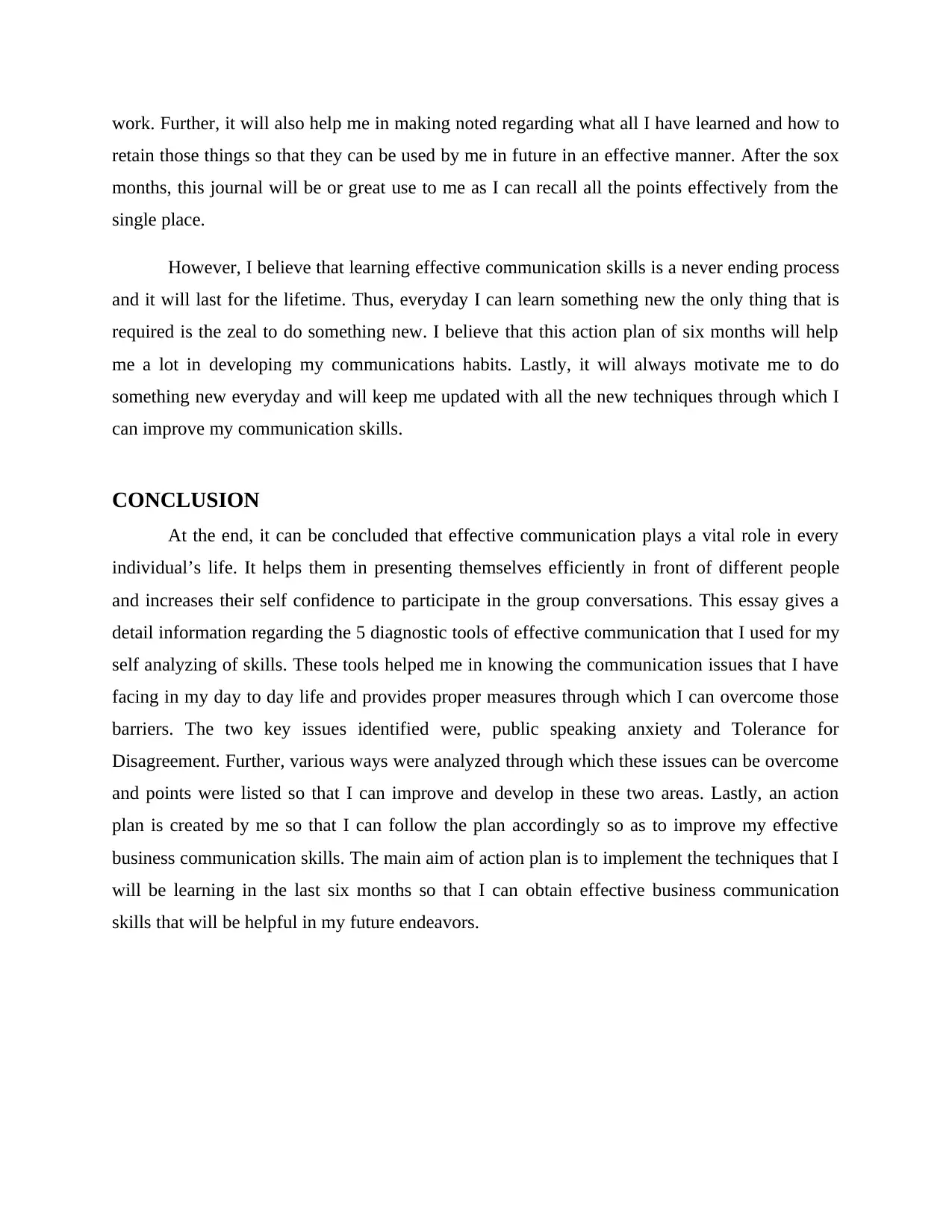
work. Further, it will also help me in making noted regarding what all I have learned and how to
retain those things so that they can be used by me in future in an effective manner. After the sox
months, this journal will be or great use to me as I can recall all the points effectively from the
single place.
However, I believe that learning effective communication skills is a never ending process
and it will last for the lifetime. Thus, everyday I can learn something new the only thing that is
required is the zeal to do something new. I believe that this action plan of six months will help
me a lot in developing my communications habits. Lastly, it will always motivate me to do
something new everyday and will keep me updated with all the new techniques through which I
can improve my communication skills.
CONCLUSION
At the end, it can be concluded that effective communication plays a vital role in every
individual’s life. It helps them in presenting themselves efficiently in front of different people
and increases their self confidence to participate in the group conversations. This essay gives a
detail information regarding the 5 diagnostic tools of effective communication that I used for my
self analyzing of skills. These tools helped me in knowing the communication issues that I have
facing in my day to day life and provides proper measures through which I can overcome those
barriers. The two key issues identified were, public speaking anxiety and Tolerance for
Disagreement. Further, various ways were analyzed through which these issues can be overcome
and points were listed so that I can improve and develop in these two areas. Lastly, an action
plan is created by me so that I can follow the plan accordingly so as to improve my effective
business communication skills. The main aim of action plan is to implement the techniques that I
will be learning in the last six months so that I can obtain effective business communication
skills that will be helpful in my future endeavors.
retain those things so that they can be used by me in future in an effective manner. After the sox
months, this journal will be or great use to me as I can recall all the points effectively from the
single place.
However, I believe that learning effective communication skills is a never ending process
and it will last for the lifetime. Thus, everyday I can learn something new the only thing that is
required is the zeal to do something new. I believe that this action plan of six months will help
me a lot in developing my communications habits. Lastly, it will always motivate me to do
something new everyday and will keep me updated with all the new techniques through which I
can improve my communication skills.
CONCLUSION
At the end, it can be concluded that effective communication plays a vital role in every
individual’s life. It helps them in presenting themselves efficiently in front of different people
and increases their self confidence to participate in the group conversations. This essay gives a
detail information regarding the 5 diagnostic tools of effective communication that I used for my
self analyzing of skills. These tools helped me in knowing the communication issues that I have
facing in my day to day life and provides proper measures through which I can overcome those
barriers. The two key issues identified were, public speaking anxiety and Tolerance for
Disagreement. Further, various ways were analyzed through which these issues can be overcome
and points were listed so that I can improve and develop in these two areas. Lastly, an action
plan is created by me so that I can follow the plan accordingly so as to improve my effective
business communication skills. The main aim of action plan is to implement the techniques that I
will be learning in the last six months so that I can obtain effective business communication
skills that will be helpful in my future endeavors.
⊘ This is a preview!⊘
Do you want full access?
Subscribe today to unlock all pages.

Trusted by 1+ million students worldwide

Paraphrase This Document
Need a fresh take? Get an instant paraphrase of this document with our AI Paraphraser
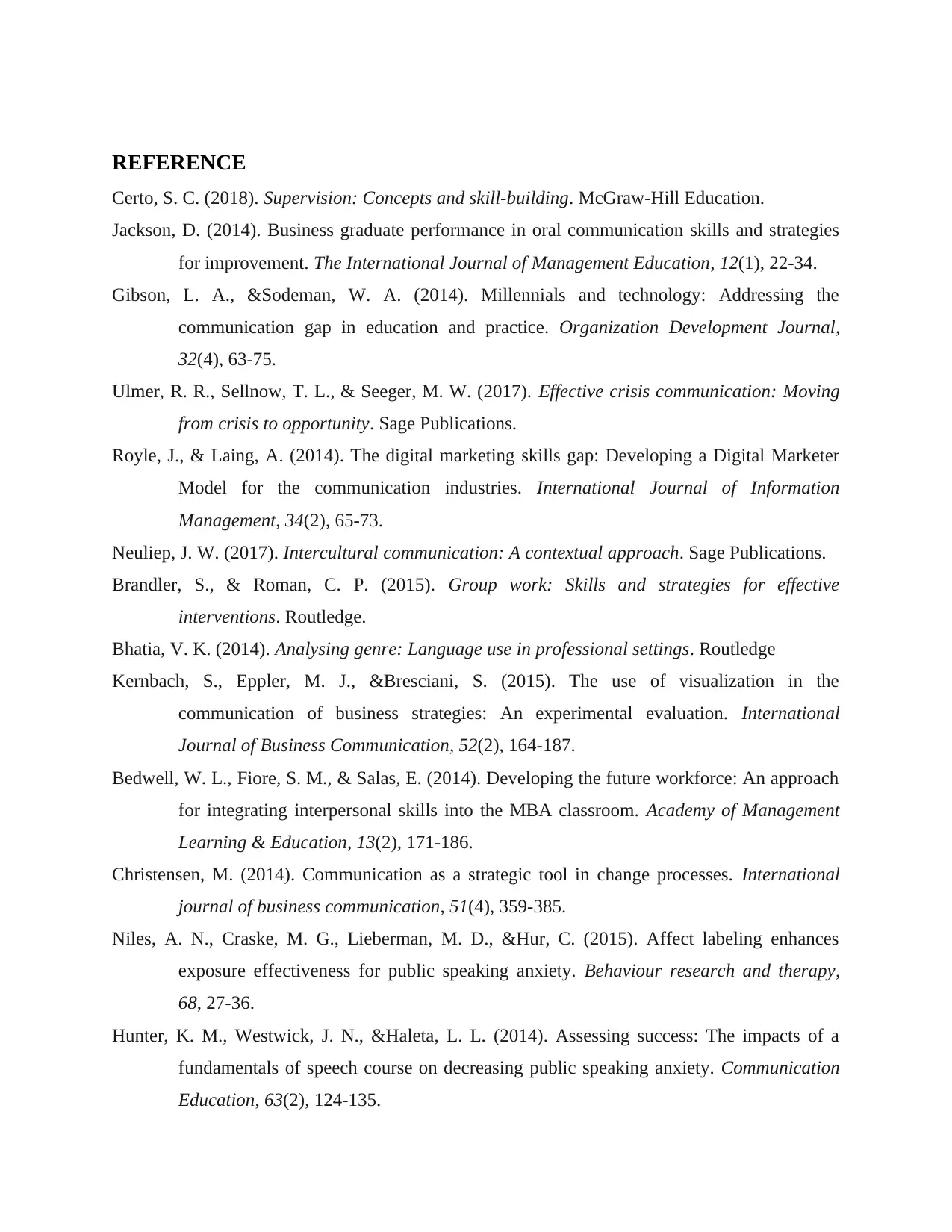
REFERENCE
Certo, S. C. (2018). Supervision: Concepts and skill-building. McGraw-Hill Education.
Jackson, D. (2014). Business graduate performance in oral communication skills and strategies
for improvement. The International Journal of Management Education, 12(1), 22-34.
Gibson, L. A., &Sodeman, W. A. (2014). Millennials and technology: Addressing the
communication gap in education and practice. Organization Development Journal,
32(4), 63-75.
Ulmer, R. R., Sellnow, T. L., & Seeger, M. W. (2017). Effective crisis communication: Moving
from crisis to opportunity. Sage Publications.
Royle, J., & Laing, A. (2014). The digital marketing skills gap: Developing a Digital Marketer
Model for the communication industries. International Journal of Information
Management, 34(2), 65-73.
Neuliep, J. W. (2017). Intercultural communication: A contextual approach. Sage Publications.
Brandler, S., & Roman, C. P. (2015). Group work: Skills and strategies for effective
interventions. Routledge.
Bhatia, V. K. (2014). Analysing genre: Language use in professional settings. Routledge
Kernbach, S., Eppler, M. J., &Bresciani, S. (2015). The use of visualization in the
communication of business strategies: An experimental evaluation. International
Journal of Business Communication, 52(2), 164-187.
Bedwell, W. L., Fiore, S. M., & Salas, E. (2014). Developing the future workforce: An approach
for integrating interpersonal skills into the MBA classroom. Academy of Management
Learning & Education, 13(2), 171-186.
Christensen, M. (2014). Communication as a strategic tool in change processes. International
journal of business communication, 51(4), 359-385.
Niles, A. N., Craske, M. G., Lieberman, M. D., &Hur, C. (2015). Affect labeling enhances
exposure effectiveness for public speaking anxiety. Behaviour research and therapy,
68, 27-36.
Hunter, K. M., Westwick, J. N., &Haleta, L. L. (2014). Assessing success: The impacts of a
fundamentals of speech course on decreasing public speaking anxiety. Communication
Education, 63(2), 124-135.
Certo, S. C. (2018). Supervision: Concepts and skill-building. McGraw-Hill Education.
Jackson, D. (2014). Business graduate performance in oral communication skills and strategies
for improvement. The International Journal of Management Education, 12(1), 22-34.
Gibson, L. A., &Sodeman, W. A. (2014). Millennials and technology: Addressing the
communication gap in education and practice. Organization Development Journal,
32(4), 63-75.
Ulmer, R. R., Sellnow, T. L., & Seeger, M. W. (2017). Effective crisis communication: Moving
from crisis to opportunity. Sage Publications.
Royle, J., & Laing, A. (2014). The digital marketing skills gap: Developing a Digital Marketer
Model for the communication industries. International Journal of Information
Management, 34(2), 65-73.
Neuliep, J. W. (2017). Intercultural communication: A contextual approach. Sage Publications.
Brandler, S., & Roman, C. P. (2015). Group work: Skills and strategies for effective
interventions. Routledge.
Bhatia, V. K. (2014). Analysing genre: Language use in professional settings. Routledge
Kernbach, S., Eppler, M. J., &Bresciani, S. (2015). The use of visualization in the
communication of business strategies: An experimental evaluation. International
Journal of Business Communication, 52(2), 164-187.
Bedwell, W. L., Fiore, S. M., & Salas, E. (2014). Developing the future workforce: An approach
for integrating interpersonal skills into the MBA classroom. Academy of Management
Learning & Education, 13(2), 171-186.
Christensen, M. (2014). Communication as a strategic tool in change processes. International
journal of business communication, 51(4), 359-385.
Niles, A. N., Craske, M. G., Lieberman, M. D., &Hur, C. (2015). Affect labeling enhances
exposure effectiveness for public speaking anxiety. Behaviour research and therapy,
68, 27-36.
Hunter, K. M., Westwick, J. N., &Haleta, L. L. (2014). Assessing success: The impacts of a
fundamentals of speech course on decreasing public speaking anxiety. Communication
Education, 63(2), 124-135.
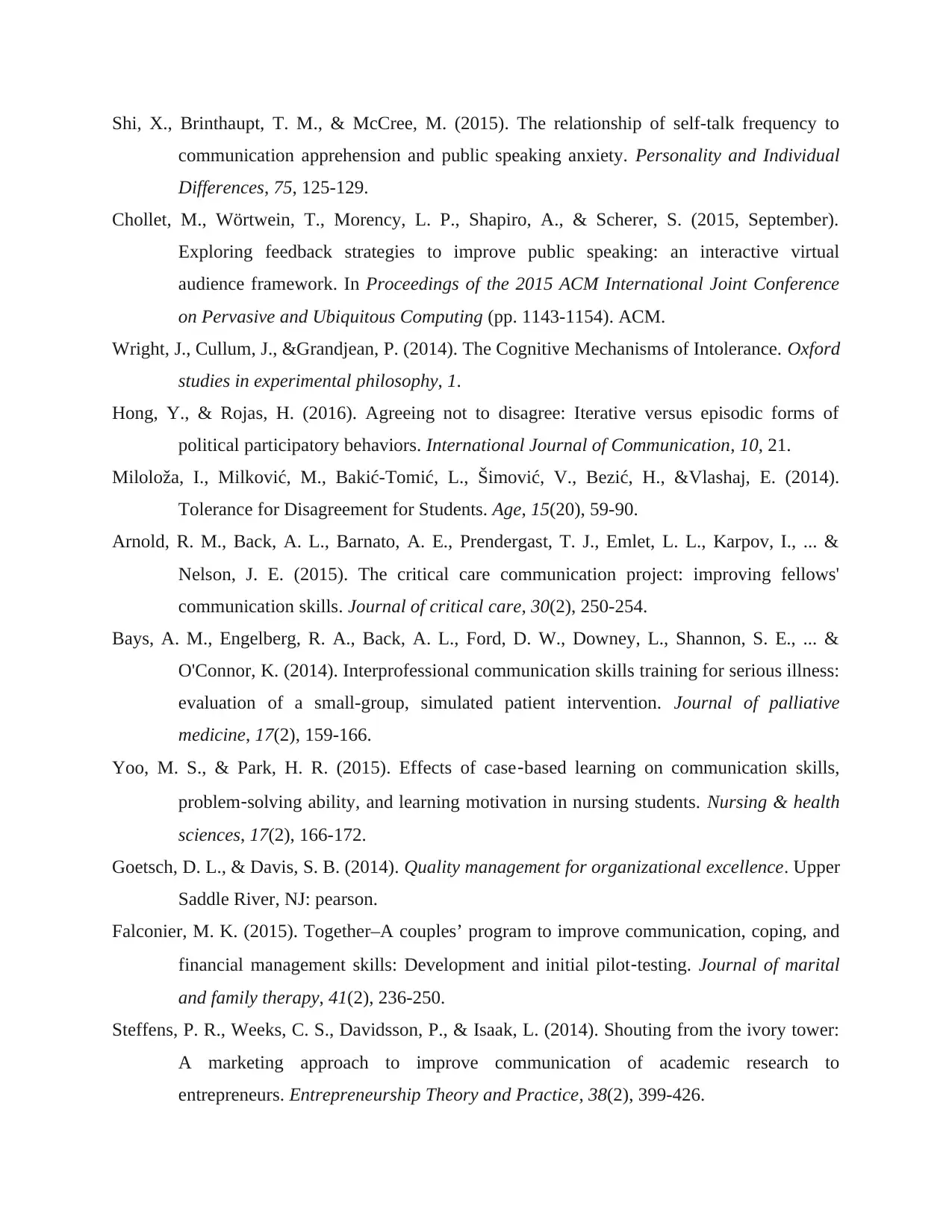
Shi, X., Brinthaupt, T. M., & McCree, M. (2015). The relationship of self-talk frequency to
communication apprehension and public speaking anxiety. Personality and Individual
Differences, 75, 125-129.
Chollet, M., Wörtwein, T., Morency, L. P., Shapiro, A., & Scherer, S. (2015, September).
Exploring feedback strategies to improve public speaking: an interactive virtual
audience framework. In Proceedings of the 2015 ACM International Joint Conference
on Pervasive and Ubiquitous Computing (pp. 1143-1154). ACM.
Wright, J., Cullum, J., &Grandjean, P. (2014). The Cognitive Mechanisms of Intolerance. Oxford
studies in experimental philosophy, 1.
Hong, Y., & Rojas, H. (2016). Agreeing not to disagree: Iterative versus episodic forms of
political participatory behaviors. International Journal of Communication, 10, 21.
Miloloža, I., Milković, M., Bakić-Tomić, L., Šimović, V., Bezić, H., &Vlashaj, E. (2014).
Tolerance for Disagreement for Students. Age, 15(20), 59-90.
Arnold, R. M., Back, A. L., Barnato, A. E., Prendergast, T. J., Emlet, L. L., Karpov, I., ... &
Nelson, J. E. (2015). The critical care communication project: improving fellows'
communication skills. Journal of critical care, 30(2), 250-254.
Bays, A. M., Engelberg, R. A., Back, A. L., Ford, D. W., Downey, L., Shannon, S. E., ... &
O'Connor, K. (2014). Interprofessional communication skills training for serious illness:
evaluation of a small-group, simulated patient intervention. Journal of palliative
medicine, 17(2), 159-166.
Yoo, M. S., & Park, H. R. (2015). Effects of case‐based learning on communication skills,
problem‐solving ability, and learning motivation in nursing students. Nursing & health
sciences, 17(2), 166-172.
Goetsch, D. L., & Davis, S. B. (2014). Quality management for organizational excellence. Upper
Saddle River, NJ: pearson.
Falconier, M. K. (2015). Together–A couples’ program to improve communication, coping, and
financial management skills: Development and initial pilot‐testing. Journal of marital
and family therapy, 41(2), 236-250.
Steffens, P. R., Weeks, C. S., Davidsson, P., & Isaak, L. (2014). Shouting from the ivory tower:
A marketing approach to improve communication of academic research to
entrepreneurs. Entrepreneurship Theory and Practice, 38(2), 399-426.
communication apprehension and public speaking anxiety. Personality and Individual
Differences, 75, 125-129.
Chollet, M., Wörtwein, T., Morency, L. P., Shapiro, A., & Scherer, S. (2015, September).
Exploring feedback strategies to improve public speaking: an interactive virtual
audience framework. In Proceedings of the 2015 ACM International Joint Conference
on Pervasive and Ubiquitous Computing (pp. 1143-1154). ACM.
Wright, J., Cullum, J., &Grandjean, P. (2014). The Cognitive Mechanisms of Intolerance. Oxford
studies in experimental philosophy, 1.
Hong, Y., & Rojas, H. (2016). Agreeing not to disagree: Iterative versus episodic forms of
political participatory behaviors. International Journal of Communication, 10, 21.
Miloloža, I., Milković, M., Bakić-Tomić, L., Šimović, V., Bezić, H., &Vlashaj, E. (2014).
Tolerance for Disagreement for Students. Age, 15(20), 59-90.
Arnold, R. M., Back, A. L., Barnato, A. E., Prendergast, T. J., Emlet, L. L., Karpov, I., ... &
Nelson, J. E. (2015). The critical care communication project: improving fellows'
communication skills. Journal of critical care, 30(2), 250-254.
Bays, A. M., Engelberg, R. A., Back, A. L., Ford, D. W., Downey, L., Shannon, S. E., ... &
O'Connor, K. (2014). Interprofessional communication skills training for serious illness:
evaluation of a small-group, simulated patient intervention. Journal of palliative
medicine, 17(2), 159-166.
Yoo, M. S., & Park, H. R. (2015). Effects of case‐based learning on communication skills,
problem‐solving ability, and learning motivation in nursing students. Nursing & health
sciences, 17(2), 166-172.
Goetsch, D. L., & Davis, S. B. (2014). Quality management for organizational excellence. Upper
Saddle River, NJ: pearson.
Falconier, M. K. (2015). Together–A couples’ program to improve communication, coping, and
financial management skills: Development and initial pilot‐testing. Journal of marital
and family therapy, 41(2), 236-250.
Steffens, P. R., Weeks, C. S., Davidsson, P., & Isaak, L. (2014). Shouting from the ivory tower:
A marketing approach to improve communication of academic research to
entrepreneurs. Entrepreneurship Theory and Practice, 38(2), 399-426.
⊘ This is a preview!⊘
Do you want full access?
Subscribe today to unlock all pages.

Trusted by 1+ million students worldwide
1 out of 13
Related Documents
Your All-in-One AI-Powered Toolkit for Academic Success.
+13062052269
info@desklib.com
Available 24*7 on WhatsApp / Email
![[object Object]](/_next/static/media/star-bottom.7253800d.svg)
Unlock your academic potential
Copyright © 2020–2025 A2Z Services. All Rights Reserved. Developed and managed by ZUCOL.


